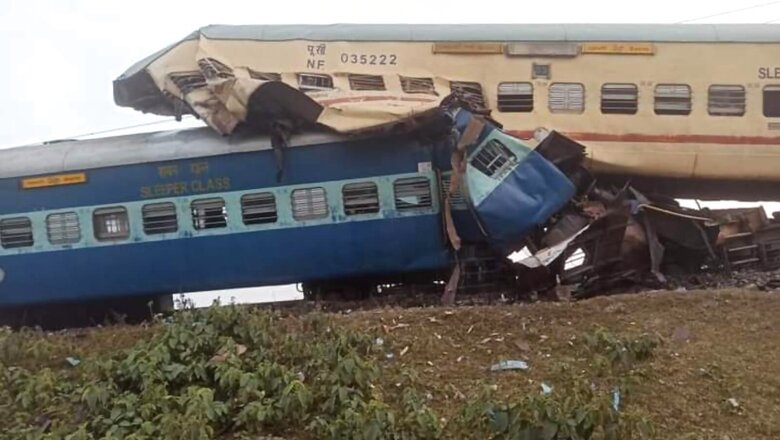
views
First insight into the preliminary findings on what may have caused the Maynaguri train accident in North Bengal suggests that a technical fault with the engine may have led to the tragedy. Railways experts have unearthed that one of the four traction motors of the WAP-4 engine, which was pulling the ill-fated 15633 Up Bikaner-Guwahati Express, fell off and forced the loco pilots to pull the emergency brakes.
The impact of the brakes on the speeding train, which was running with the old and heavy Integral Coach Factory (ICF) bogies, and the last two wheel assemblies of the loco jumping tracks despite the brakes applied possibly led to a complete derailment of the first 12 of the 24 coaches immediately following the engine and at least two compartments sliding over one another.
A thorough probe into the cause of the accident initiated by the Commissioner of Railway Safety is scheduled to submit its report to the Rail Ministry soon.
Official records state that of the 1,053 passengers on board the train at the time of the accident (around 5 pm on Thursday), nine are dead and nearly 40 have been hospitalised, about 10 of whom are in critical condition.
The function of a traction motor is to generate power to rotate the wheels of the engine and is typically mounted in the trucks where the wheels are housed, a railway official explained. A WAP-4 engine, which is a 4th generation class of 25 kV AC electric locomotive whose production has ceased since August 2016, runs on 12 wheels.
The application of the emergency brakes evidently had a massive impact on the coaches and the unsuspecting passengers within them, especially since and contrary to initial perceptions, the speeding train was not passing through an elephant corridor and was hence not moving at restricted speed than what is prescribed in the railways rulebook.
The rulebook states that trains equipped with ICF coaches should not exceed a speed limit of 66 kmph. Whether or not the Bikaner Express was maintaining the speed limit at the time of the accident can only be ascertained after examining the Engine Data Recorder (EDR), the official maintained.
The damage as a result of the shock after the emergency braking system was applied, according to some railway experts, was perhaps more extensive because the now-decommissioned ICF coaches attached to the engine are heavier and less stable at high speed compared to the, say, German technology-based Linke Hofmann Busch (LHB) coaches which are now in use in a considerable number long-distance trains.
Although production of ICF coaches has stopped since 2018, these rakes are still in use in a majority of trains, like in the Bikaner-Guwahati Express, and are believed to be a compromise on passenger safety. The modern LHB coaches, loaded with the Central Buffer Coupling (CBC) system have been found to be better shock absorbers compared to the screw-based coupling of their ICF counterparts since the former is able to transmit shocks across all rakes unlike the latter.
Even the LHB technology is dated. Indian Railways has voiced its intentions to replace that with the state-of-the-art trainsets on which ultra-high-speed trains like Vande Bharat Express are supposed to run, amid controversial suggestions to privatise a part of the sector.
But even before that plan is executed, clearly the need of the hour in the interest of passenger safety is to do away with the vintage ICF coaches and replace them with modern lightweight counterparts. That’s the lesson that the Railways Ministry could learn from this tragedy which struck the nation at the cost of nine lives, say observers.
Read all the Latest India News here















Comments
0 comment